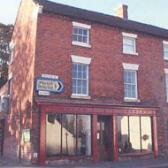Village of Hodnet
Region: West Midlands
Unitary Authority: Shropshire
Owner Type: Many
Funding Body: HERS (EH); Private; Public
Year of Intervention: 1999 - 2002
Summary: Hodnet- diversifying the rural economy in a large Shropshire village through the aid of the Heritage Economic Regeneration Scheme (HERS)
Description: The village of Hodnet has a population of approximately 1,500 and is one of the larger rural settlements in North Shropshire. It is located within as extensive rural parish between the two market towns of Wem and Market Drayton. Hodnet was designated a conservation area in 1977.
Issue: The economy of the area was traditionally based on agriculture and related industries. However over the past 30 years there has been a significant loss of jobs in agriculture, which has led to a gradual diversification of the local economy. The village serves a significant catchment population and provides a range of important services. Hodnet Hall Gardens and other local tourist attractions also contribute to the local economy. Figures from the 1997 New Earnings Survey show that Shropshire wages are considerably lower than the average for Great Britain: the county ranked 13th lowest out of the total 85 counties. A ‘buildings at risk’ survey conducted in 1999 on all traditional buildings in the conservation area revealed that over half the buildings were at risk or vulnerable. Hodnet also suffered from the busy winding main road carrying heavy goods vehicles through the village.
Strategy: The Hodnet HERS commenced in 1999. Prior to this, North Shropshire District Council served a Compulsory Purchase Order on Walford House, a derelict Grade II listed building occupying a prominent position in the centre of the conservation area. A multifaceted approach was taken to address the problems at in Hodnet, which included building a bypass, work by the rural development fund and historic buildings repairs under the HERS. The scheme proposed a need to tackle the problems of buildings suffering through disrepair, vacancy and underuse. These problems were heightened by socio-economic issues in the area and low rents leading to very limited levels of repair.English Heritage funding of £91,117 levered £438,434 of additional public and private funding.
Outcome: Since 1999 the HERS has provided financial assistance for the refurbishment of seven properties comprising 15 units, including five shops and one workshop. In addition, the scheme has provided support for three environmental enhancement schemes. One major project has been the repair of Walford House. Following compulsory purchase the house was sold through a careful tendering process and after 25 years of neglect the new owner has repaired the building with the aid of a HERS grant. Holyrood house on Shrewbury Street was another large project. The HERS has levered a large amount of private investment into the village, and as a result of the impact of the scheme, it is expected that visitor rates to the village will increase, bringing more investment into the village economy.
Keywords: Grants, Regeneration, Repair, Reconstruction & Restoration
© English Heritage

